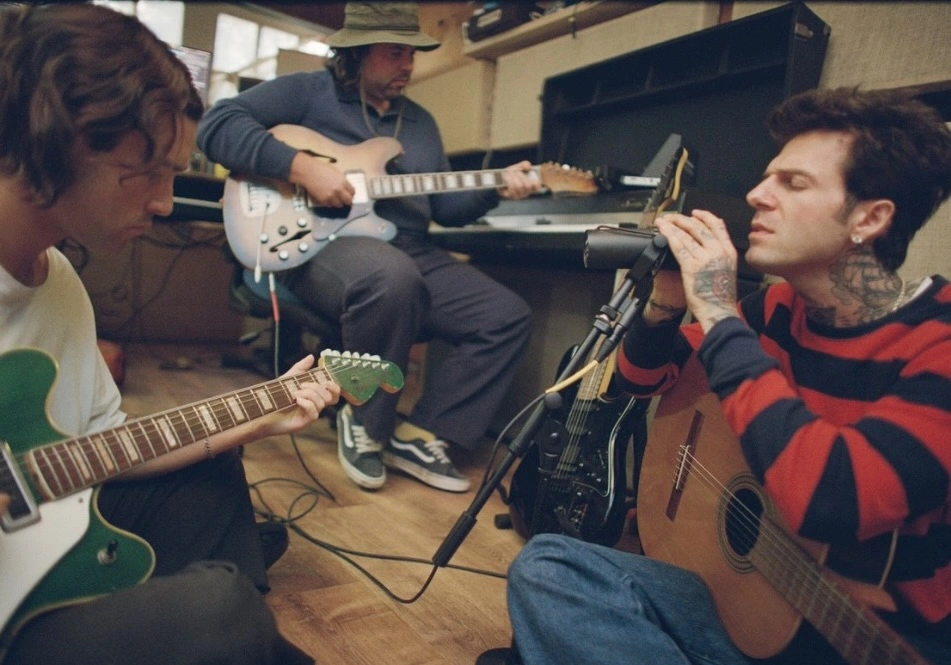When Western Sydney drill pioneers ONEFOUR announced a new single featuring The Kid LAROI and the ethereal English innovator Imogen Heap, few could have predicted the result. The track, titled Distant Strangers, isn’t merely a cross-genre experiment; it’s a bold testament to music’s power to bridge seemingly unbridgeable divides.
The connection is surprising on many levels. ONEFOUR, known for their raw, street-focused drill anthems, have built a reputation as Australia’s most influential — and often controversial — rap collective. Meanwhile, The Kid LAROI has cemented himself as a global pop-rap star, celebrated for his vulnerable hooks and arena-ready energy. Add Imogen Heap, the avant-garde singer-songwriter and producer known for her ethereal harmonies and electronic experimentation, and you have a collision of worlds that few would have imagined.
An unlikely union
ONEFOUR rose to prominence through uncompromising storytelling about life in Sydney’s Mount Druitt, documenting hardship, brotherhood, and survival. Songs like “The Message” and “Spot the Difference” carried an aggressive honesty, landing them in the crosshairs of Australian law enforcement and conservative media. Despite challenges, they maintained a loyal fanbase and began to earn respect globally, positioning themselves as leaders of the Australian drill movement.
The Kid LAROI, born Charlton Howard, shares a different but equally turbulent background. Also hailing from Australia, he grew up moving between Sydney and rural New South Wales before making a meteoric leap to global stardom in Los Angeles. Known for hits like “STAY” and “WITHOUT YOU,” LAROI’s blend of melodic rap and emotional pop resonated with a generation raised on heartbreak and social media self-discovery.
Then there’s Imogen Heap: a musical shapeshifter, innovator, and a quietly revolutionary figure in the music world. Her song “Hide and Seek” has become a timeless anthem, sampled and reimagined across genres. Beyond her own recordings, she has pioneered tech innovations like the Mi.Mu gloves for gestural music control, proving her status as an artist deeply invested in the intersection of sound and technology.
Bringing these three distinct forces together on Distant Strangers feels, on paper, like an impossible experiment. Yet, in execution, it creates something deeply affecting and surprisingly cohesive.
A sonic tapestry
From its first notes, Distant Strangers announces itself as a departure. Rather than opening with the menacing basslines typical of drill, the track begins with a minimal, almost ghostly synth bed — a clear nod to Heap’s sonic palette. Her layered, processed vocals create an atmosphere of floating melancholy, like a lonely transmission across a vast digital expanse.
Then, the beat drops — heavy, percussive, unmistakably ONEFOUR — but softened and more contemplative than their usual fare. J Emz and Spenny trade verses that reveal a more reflective side of the group, discussing alienation, regret, and the fragility of modern relationships. The raw aggression of drill is still present but repurposed into something introspective and atmospheric.
The Kid LAROI enters on the chorus, his distinctive voice immediately cutting through. Singing, “We’re all just distant strangers in each other’s lives / Holding on to memories we can’t revive,” he captures the heart of the track in one melancholy refrain. His melodic sensibility anchors the song, making it accessible without diluting its emotional depth.
Heap’s bridge, meanwhile, is the track’s secret weapon. Delivered with her signature blend of processed harmonies and poetic phrasing, her verse reads like a digital haiku: “Signals break in pixel skies / We echo through electric sighs.” The effect is hypnotic, creating a dreamy pause before the final surge of the chorus.
Lyrical vulnerability
What makes Distant Strangers so compelling isn’t just the fusion of styles — it’s the emotional honesty at its core. ONEFOUR, often portrayed as aggressive and confrontational, show a vulnerability here that feels both surprising and authentic. Their verses reveal the loneliness and emotional fallout that can follow fame, violence, and public scrutiny. Lines like, “Got brothers that I’ve lost to the system, now I’m losing myself in the distance,” showcase an unexpected poetic depth.
LAROI’s chorus amplifies this vulnerability, shifting the song away from bravado and toward something more universally human: the fear of disconnection. Heap’s abstract yet evocative lines deepen this emotional terrain, inviting listeners to interpret and internalize the song’s message in their own way.
A striking visual narrative
The music video for Distant Strangers is as ambitious as the song itself. Directed by Nabil Elderkin, known for his surreal, cinematic work with Kanye West and Frank Ocean, the video juxtaposes stark Sydney street scenes with digital dreamscapes.
ONEFOUR perform their verses under flickering streetlights, conveying the harsh realities of their environment, while LAROI appears alone in a cavernous warehouse bathed in cold blue light, emphasizing themes of isolation and inner turmoil. Heap floats through fragmented digital environments — sometimes dissolving into pixels, sometimes emerging as a ghostly silhouette — symbolizing the intangible, often unreachable nature of human connection in the digital age.
The climax of the video sees all three artists momentarily sharing the same space, visually connected but never quite touching — a powerful representation of the song’s central theme.
Cultural and global impression
Distant Strangers represents more than just an intriguing sonic experiment; it’s a cultural moment that reframes each artist’s narrative. For ONEFOUR, it is a bold expansion beyond their drill roots, demonstrating their ability to engage with broader emotional and musical landscapes.
For The Kid LAROI, it is another step in a journey toward artistic maturity, hinting at a future beyond radio-ready heartbreak anthems. For Imogen Heap, it is a reminder of her continuing relevance and her rare ability to elevate any collaboration into something transcendent.
The song has ignited discussions online and in music circles, with fans and critics alike praising its unexpected synergy and emotional depth. It highlights a growing trend in global music: a move away from strict genre boundaries toward open, expressive, and sometimes vulnerable cross-pollination.
The future beyond the track
While Distant Strangers may stand as a singular artistic statement, it also opens doors. There’s speculation about future collaborations among these artists, or even a larger project exploring similar themes.
What is certain is that the song has expanded possibilities for each artist while challenging listeners to embrace complexity. It suggests that vulnerability and experimentation are not weaknesses but pathways to deeper connection and artistic growth.
A powerful statement
In an era dominated by algorithmic sameness and risk-averse releases, Distant Strangers feels like a breath of fresh air — a testament to what can happen when artists step outside their comfort zones and trust in each other’s creative instincts.
It is a song that speaks to loneliness, fame, brotherhood, and digital alienation all at once, embodying both its title and its creators’ shared humanity. Whether blasting from car speakers or echoing through headphones late at night, Distant Strangers is a song that stays with you — a beautiful, haunting reminder that even in a crowded world, we can still feel like distant strangers to each other and to ourselves.
No comments yet.








